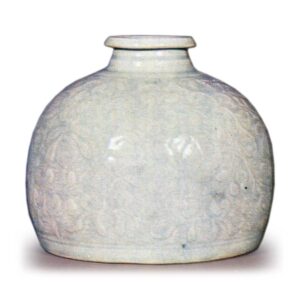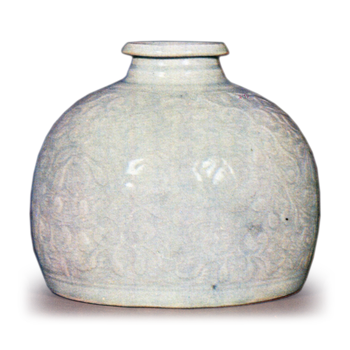
A thin, translucent white porcelain body coated with a pale blue transparent glaze. The glaze accumulates on the surface of the porcelain, where patterns such as painted and inlaid flowers are engraved, making it appear bluer than other porcelain. In recent years, the term “blue and white porcelain” has come to be used, but this is in response to the term “blue and white chinpai” used in Europe and the United States. In the past, there were only a few pieces of celadon porcelain that attracted the attention of celadonologists, but later they were unearthed from various parts of China, from the tombs of the Goryeo Dynasty in Korea, from the Sutra Mound site in Japan, and from countless sites in the South Sea and the Orient. The distribution of these works has reached a global scale, and many of them are excellent, making them famous. Inchines were produced in large quantities during the Song and Yuan dynasties, and the main production area was the Jingdezhen kilns in Fuiliang County, Jiangxi Province. However, in the Jiangxi, Fujian, and Guangdong provinces of Jiangnan, blue-and-white porcelain-style ceramics made by reduction-firing of ash glaze were produced from early times, and it is possible that there are even older examples of inchin, and since the objects are classified in various degrees of fineness and coarseness, it is assumed that kilns other than Jingdezhen also produced in this region. The variety of Inch ware is extremely diverse, ranging from vases, water jars, incense burners, and bottles to bowls, plates, bowls, cups, and cups.
The finest pieces are made with a thin clay body and polished with patterns, then covered with an ash glaze containing trace amounts of iron and fired in a reduction kiln. When these types of vessels are exposed to the sun, it is often possible to see through the body. As the period progressed, the vessels became thicker, and the techniques varied: some had patterns stamped on them, others were pasted or itched, and still others had designs made by pasting bead-like bead-dui lines on them. Finally, blue-and-white porcelain, so-called “underglaze blue and white porcelain,” emerged.



